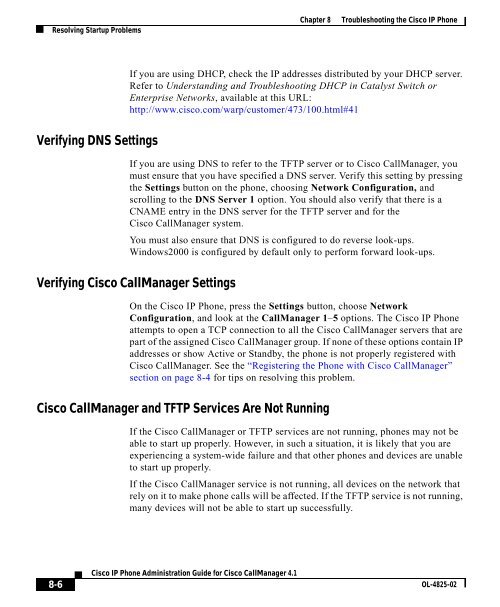8 Troubleshooting the Cisco IP Phone
8 Troubleshooting the Cisco IP Phone
8 Troubleshooting the Cisco IP Phone
You also want an ePaper? Increase the reach of your titles
YUMPU automatically turns print PDFs into web optimized ePapers that Google loves.
Resolving Startup ProblemsChapter 8 <strong>Troubleshooting</strong> <strong>the</strong> <strong>Cisco</strong> <strong>IP</strong> <strong>Phone</strong>If you are using DHCP, check <strong>the</strong> <strong>IP</strong> addresses distributed by your DHCP server.Refer to Understanding and <strong>Troubleshooting</strong> DHCP in Catalyst Switch orEnterprise Networks, available at this URL:http://www.cisco.com/warp/customer/473/100.html#41Verifying DNS SettingsIf you are using DNS to refer to <strong>the</strong> TFTP server or to <strong>Cisco</strong> CallManager, youmust ensure that you have specified a DNS server. Verify this setting by pressing<strong>the</strong> Settings button on <strong>the</strong> phone, choosing Network Configuration, andscrolling to <strong>the</strong> DNS Server 1 option. You should also verify that <strong>the</strong>re is aCNAME entry in <strong>the</strong> DNS server for <strong>the</strong> TFTP server and for <strong>the</strong><strong>Cisco</strong> CallManager system.You must also ensure that DNS is configured to do reverse look-ups.Windows2000 is configured by default only to perform forward look-ups.Verifying <strong>Cisco</strong> CallManager SettingsOn <strong>the</strong> <strong>Cisco</strong> <strong>IP</strong> <strong>Phone</strong>, press <strong>the</strong> Settings button, choose NetworkConfiguration, and look at <strong>the</strong> CallManager 1–5 options. The <strong>Cisco</strong> <strong>IP</strong> <strong>Phone</strong>attempts to open a TCP connection to all <strong>the</strong> <strong>Cisco</strong> CallManager servers that arepart of <strong>the</strong> assigned <strong>Cisco</strong> CallManager group. If none of <strong>the</strong>se options contain <strong>IP</strong>addresses or show Active or Standby, <strong>the</strong> phone is not properly registered with<strong>Cisco</strong> CallManager. See <strong>the</strong> “Registering <strong>the</strong> <strong>Phone</strong> with <strong>Cisco</strong> CallManager”section on page 8-4 for tips on resolving this problem.<strong>Cisco</strong> CallManager and TFTP Services Are Not RunningIf <strong>the</strong> <strong>Cisco</strong> CallManager or TFTP services are not running, phones may not beable to start up properly. However, in such a situation, it is likely that you areexperiencing a system-wide failure and that o<strong>the</strong>r phones and devices are unableto start up properly.If <strong>the</strong> <strong>Cisco</strong> CallManager service is not running, all devices on <strong>the</strong> network thatrely on it to make phone calls will be affected. If <strong>the</strong> TFTP service is not running,many devices will not be able to start up successfully.8-6<strong>Cisco</strong> <strong>IP</strong> <strong>Phone</strong> Administration Guide for <strong>Cisco</strong> CallManager 4.1OL-4825-02
















